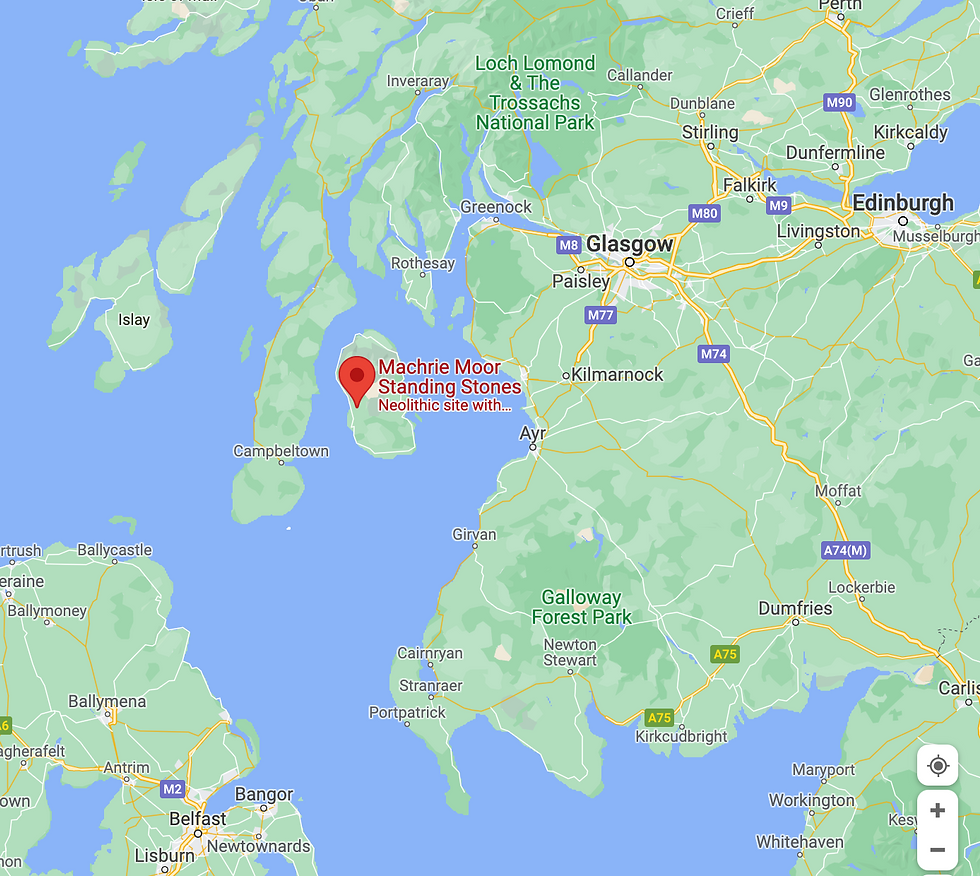Standing Stones of Scotland: Machrie Moor
- Lyn (aka Jazz)

- Feb 28, 2022
- 4 min read
Updated: Oct 22, 2023
updated March 2023
The popularity of Diana Gabaldon's book and now TV series, Outlander, introduced many people to henges also known as stone circles. Many had heard of Stonehenge, of course, but few outside of the UK knew that Stonehenge is only one of the many prehistoric circles that remain today. Many of these stone circles can be found in Scotland. Today's post will visit the Isle of Arran, Scotland to explore the Machrie Moor Farm site.
An Overview of Machrie Moor
This site is more accurately referred to as a collection of Neolithic monuments rather than a stone circle. It includes the remains of up to 10 Bronze Age circles, hut circles, standing stones, and cairns that are clustered around the moor. It is considered one of the most important sites of its kind in Britain.

The earliest construction seems to have begun about 3,500 BCE, when pits were dug in the two furthest areas of the site. A thousand years later, timber circles were erected on the sites of the earlier pits. Over time, the wood poles forming the circles rotted away, and the land was divided into small farming plots and ploughed. Then, in about 2,000 BC, stone circles were built on top of the two earlier wood circles. It is thought that the four other stone circles were built in the same period.

Machrie Moor Farm Site
There are many reasons to spend some time on the Isle of Arran in Scotland, but one of those is to visit the Machrie Moor Farm site. As a huge fan of the Outlander books, I was immediately interested in seeing some of these less famous henges for myself. We followed guidebook suggestion and found ourselves pulling into a parking lot seemingly in the middle of nowhere. The signage is discrete but, with little else around, easy enough to spot.

Be aware that there are no guides, signage, or human interpreters at the site, so you will need to do your homework (or review this post) before visiting to understand what you are seeing. Several guides suggested two hours would be enough time to visit the site. I believe Mady and I were there almost twice as long.
The pathway from the parking to the site goes through a field of grazing sheep and all the sheep sh!t that they produce. Pro tip: Wear boots and don't forget to knock the dirt and manure off your boots when you return to the car... the smell lingers.

Stone Circles and Farm Site
The first stones we saw were part of the Moss Farm Road Stone Circles. These might have been constructed to be burial tombs. All the sites became burial tombs at some point but opinions differ as to whether this is a burial cairn or a stone circle in which a later burial took place.

The path continues and leads to the long-ruined Moss Farm. This was obviously a working farm in the much more recent past but I've been unable to find that information. I always enjoy poking around in derelict buildings, so I found many things to point my camera at.

The next section where we wandered is a double stone circle nicknamed "Fingal's Cauldron Seat". According to legend, the giant Fingal sat down to cook a meal there and tied his dog to a stone in the outer circle with a hole through it.

Stone Circle #3 originally had nine stones in an oval shape but only one is currently standing. Excavations during the mid-nineteenth century discovered burnt bone and flint flakes in cysts buried in the center of the oval. In this shot, you can see Circle #2, which is the star of the show, in the background.

The star of the site is Circle No.2. At first sight, this seems less like a stone circle than a group of three upright sandstone slabs of varying heights up to 5.5m (18 ft) but as you walk around, it becomes clear where previous stones would have been standing. Remarkably, any of these stones remain standing considering the age and the terrific storms that are common in the area.
The question that I wanted answered is "Why are so many circles on the moor?" I spent several hours doing some research and discovered that this moor is flat enough that the sun tracks clearly across the ground. Some experts say that the circles form several astronomical alignments including midsummer sunrise and midwinter moon. It appears that this area was consistently populated and farmed over the years, which led to more permanent displays. Local practitioners of Druid rituals still gather at the site during the high days of pagan celebrations. We enjoyed our stop to explore the Standing Stones of Machrie Moor. It was a great way to stretch our legs and enjoy the fresh air, as well as an opportunity to check if the stones would hum for us. (They didn't)
If you are enjoying the content and would like to be updated with new posts become a member/subscribe (it's free!) and follow along on the RamblynJazz Facebook page, Facebook Group, Twitter, and Instagram. You can help the blog to grow by sharing the link with a travelling friend or through social media. I truly appreciate your comments and encourage you to share your thoughts below.







Comments